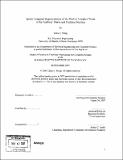Spatio-temporal representation of the pitch of complex tones in the auditory nerve and cochlear nucleus
Author(s)
Wang, Grace I
DownloadFull printable version (8.776Mb)
Other Contributors
Massachusetts Institute of Technology. Dept. of Electrical Engineering and Computer Science.
Advisor
Bertrand Delgutte.
Terms of use
Metadata
Show full item recordAbstract
Traditional models for pitch processing have relied either on a purely spatial representation based on the frequency selectivity and frequency-to-place mapping in the cochlea, or on a purely temporal representation dependent on neural phase locking to the stimulus period. However, rate-place cues to the pitch of harmonic complex tones in the auditory nerve (AN) saturate at high levels, and temporal cues fail to predict the strong pitch of resolved harmonics. Thus, neither pitch representation accounts for all key psychophysical observations. Recently, it has been shown that the AN also contains spatio-temporal cues to the individual harmonics of a complex tone that might be used in pitch extraction and are more consistent with psychophysical data (Cedolin 2006) This thesis aims to evaluate whether these cues are extracted in cochlear nucleus (CN) neurons, which receive inputs from AN fibers. We used transient complex stimuli ("Huffman sequences") designed to manipulate the relative timing between adjacent AN fibers to evaluate sensitivity of CN units to the spatio-temporal pattern of their inputs. A small minority of units were sensitive to the stimulus manipulations, with only a few sensitive in the direction consistent with cross-frequency coincidence detection. We also measured the strength of the rate representation for the pitch of harmonic complex tones in CN units and found a few units that maintained salient pitch cues at high stimulus levels. However there was no obvious correlation between spatio-temporal sensitivity and robust pitch cues. Instead of a conversion of spatio-temporal cues in the AN into rate cues, our results indicate that temporal sharpening occurs at the level of the CN.
Description
Thesis (S.M.)--Massachusetts Institute of Technology, Dept. of Electrical Engineering and Computer Science, 2007. Includes bibliographical references (leaves 73-79).
Date issued
2007Department
Massachusetts Institute of Technology. Department of Electrical Engineering and Computer SciencePublisher
Massachusetts Institute of Technology
Keywords
Electrical Engineering and Computer Science.